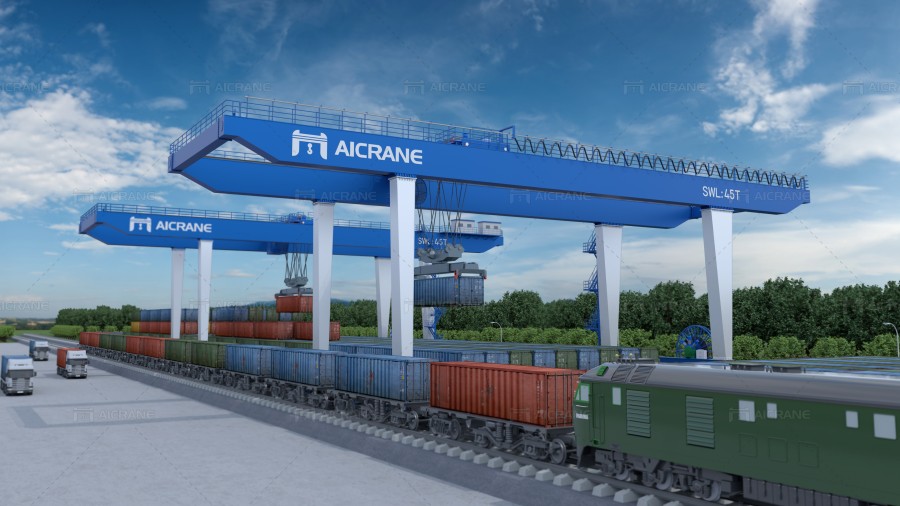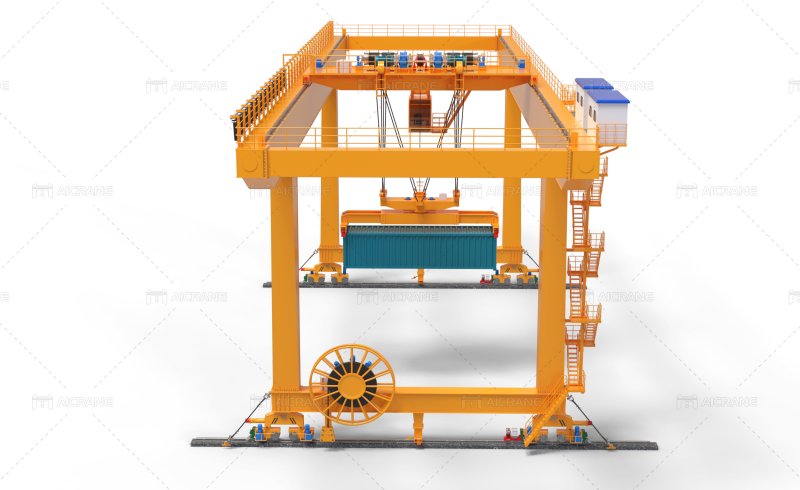Container yards are a critical component of the global supply chain, serving as temporary storage and transfer points for shipping containers in between their journey on ships, trucks, and trains. Efficient operation of container yards is crucial to ensuring that goods move swiftly and smoothly through the logistics network. Container gantry cranes play a pivotal role in achieving this efficiency, and in this article, we will explore how these machines are essential in maximizing container yard efficiency.

The Role of Container Yards in the Supply Chain
Container yards, also known as container terminals or depots, serve as crucial nodes in the complex network of international trade and logistics. These yards are the intermediaries where containers are transferred between various modes of transportation, such as ships, trucks, and trains. The primary functions of container yards include:
Transshipment: Containers arriving at the yard from ships need to be efficiently transferred to trucks or trains for onward transportation to their final destination. Similarly, containers arriving from trucks or trains need to be loaded onto ships for export.
Temporary Storage: Container yards provide temporary storage for containers in between transfers and during customs inspections, ensuring that the containers are secure and readily available when needed.
Repositioning: Containers are often moved within the yard to optimize their position for loading onto the next mode of transportation. Gantry cranes are instrumental in this task.
Maintenance and Repair: Containers that require maintenance or repair can be serviced within the container yard.
Efficiency in a container yard is measured by the speed and accuracy with which these tasks are accomplished. The efficient movement of containers within the yard directly impacts the overall supply chain, affecting everything from delivery times to shipping costs.
The Role of Gantry Cranes in Container Yards
Container gantry cranes, also known as rubber-tired gantry (RTG) cranes, are a crucial part of container yard infrastructure. These cranes are specifically designed to handle and move containers efficiently within the yard. Here are some key roles and features of gantry cranes in container yards:
Stacking and Unstacking: Gantry cranes are used to stack containers vertically, creating tall stacks that optimize the use of space in the yard. When a container is needed for transfer, the crane can efficiently unstack it from the stack.
Precision Handling: Gantry cranes offer precise control, allowing them to handle containers with care and accuracy. This is particularly important when dealing with fragile or high-value cargo.
Mobility: Unlike traditional ship-to-shore container cranes, gantry cranes in container yards are typically mounted on rubber tires, providing mobility to move along the yard and reach containers at different locations. This mobility is essential for repositioning containers and optimizing storage space.
Customization: Gantry cranes can be customized to accommodate various container sizes and stack configurations, making them versatile tools for yard operations.
Efficiency and Productivity: Gantry cranes are equipped with modern technology, such as automation and computerized controls, to maximize efficiency and productivity. Operators can manage multiple tasks and containers simultaneously.

Maximizing Container Yard Efficiency
Efficiency in a container yard revolves around optimizing several key factors, all of which are heavily influenced by the use of gantry cranes:
Space Utilization: Gantry cranes play a pivotal role in ensuring that the available yard space is used to its maximum potential. By efficiently stacking and unstacking containers, they reduce the footprint required for storage.
Throughput: The speed at which containers are transferred between different modes of transportation is a significant factor in yard efficiency. Gantry cranes, with their precision and mobility, contribute to high throughput rates.
Safety: Safety is paramount in container yard operations. Gantry cranes are equipped with safety features and technologies to prevent accidents and ensure the well-being of workers and cargo.
Flexibility: Container yards must be able to adapt to changing conditions and operational demands. Gantry cranes can easily reposition containers to accommodate fluctuations in container arrivals and departures.
Maintenance and Downtime: Efficient maintenance and repair operations are essential to minimize downtime. Double beam gantry cranes can facilitate the movement of containers in need of service, ensuring that they are quickly attended to and back in operation.
Technological Advancements
In recent years, technological advancements have played a significant role in enhancing the efficiency of container yards and the operation of gantry cranes. Some notable technological innovations include:
Automation: The automation of gantry cranes allows for precise and rapid container handling, reducing the reliance on manual labor. Automated gantry cranes can work around the clock, further increasing efficiency.
Internet of Things (IoT): IoT sensors and devices can be integrated into gantry cranes to monitor and optimize their performance. Data from these sensors can be analyzed to identify areas for improvement.
Predictive Maintenance: Predictive maintenance uses data and analytics to predict when maintenance is needed, reducing the likelihood of equipment failure and costly downtime.
Remote Operation: Some gantry cranes can be operated remotely from a control center, allowing operators to manage multiple cranes simultaneously and improving the safety and efficiency of yard operations.
Sustainability in Container Yards
Sustainability is an increasingly important aspect of container yard operations. As global awareness of environmental issues grows, container yards are seeking ways to reduce their carbon footprint. Gantry cranes can contribute to sustainability efforts in several ways:
Electrification: Transitioning from diesel-powered gantry cranes to electric ones significantly reduces emissions and noise pollution. Electric cranes can be powered by clean energy sources.
Renewable Energy: Some container yards are exploring the use of renewable energy sources, such as wind or solar power, to supply the electricity needed to operate gantry cranes.
Energy-Efficient Design: Modern gantry cranes are being designed with energy efficiency in mind, from the materials used to the components that reduce energy consumption.
Efficiency in container yards is paramount to the smooth flow of goods through the global supply chain. Container gantry cranes equipment are indispensable tools in maximizing this efficiency. Their roles in stacking, unstacking, and repositioning containers, along with their precision, mobility, and technological advancements, are key drivers in optimizing yard operations. As the world becomes more focused on sustainability and technological innovation, the role of gantry cranes in container yards will continue to evolve, contributing to greener and more efficient supply chain operations.